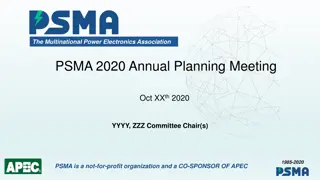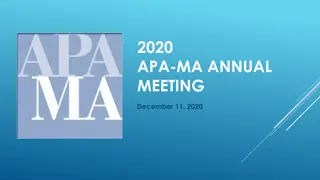
Decays in the MSSM with Quark Flavor Violation & Higgs Boson Studies
Explore the decays of the Higgs boson in the MSSM with quark flavor violation, focusing on c, b, and s quark decays and their implications. Understand the parameters and constraints of the MSSM, including QFV parameters and key considerations. Dive into the possibilities of the SM-like Higgs boson discovered at LHC and its potential new physics implications. Access insightful research references and detailed analysis of the Higgs boson in the context of the MSSM.
Download Presentation

Please find below an Image/Link to download the presentation.
The content on the website is provided AS IS for your information and personal use only. It may not be sold, licensed, or shared on other websites without obtaining consent from the author. If you encounter any issues during the download, it is possible that the publisher has removed the file from their server.
You are allowed to download the files provided on this website for personal or commercial use, subject to the condition that they are used lawfully. All files are the property of their respective owners.
The content on the website is provided AS IS for your information and personal use only. It may not be sold, licensed, or shared on other websites without obtaining consent from the author.
E N D
Presentation Transcript
0 The decays to c c , , b b , b s , g g g g, g g in the light of the MSSM with quark flavor violation (125 ) h K. Hidaka Tokyo Gakugei University Collaboration with H. Eberl, E. Ginina References: Phys. Rev. D 91 (2015) 015007 [arXiv:1411.2840 [hep-ph] ] JHEP 1606 (2016) 143 [arXiv:1604.02366 [hep-ph]]] IJMP A34 (2019) 1950120 [arXiv:1812.08010 [hep-ph]] ILC-JP end-of-year physics and detector meeting, 13 Mar. 2020, KEK
Contents 1. Introduction 2. MSSM with QFV 3. Constraints on the MSSM 4. Parameter scan for h0 c c , b b , b s in the MSSM 5. h0 c c , b b , b s in the MSSM 6. h0 g g g g, , g g in the MSSM 7. Conclusion
~u 1. Introduction 2 , 1 What is the SM-like Higgs boson discovered at LHC? It can be the SM Higgs boson. It can be a Higgs boson of New Physics. This is one of the most important issues in the present particle physics field! 0 Here we study a possibility that it is the lightest Higgs boson of the h Minimal Supersymmetric Standard Model (MSSM), focusing on the decays h0(125) c c , b b , b s , , g g g g, , g g.
2. MSSM with QFV The basic parameters of the MSSM with QFV: tan , mA, M1, M2, M3, , , M2Q, , M2U, , M2D, , TU , TD ( (at Q = 1 TeVscale ) ) ( , , = = , , , , = = u, c, t or d, s, b) tan mA : CP odd Higgs boson mass (pole mass) ratio of VEV of the two Higgs doublets <H0 2>/<H01> M1,M2,M3 : U(1), SU(2),SU(3) gaugino masses higgsino mass parameter M2Q, left squark soft mass matrix M2U right up-type squark soft mass matrix M2D right down-type squark soft mass matrix TU trilinear coupling matrix of up-type squark and Higgs boson TD trilinear coupling matrix of down-type squark and Higgs boson
Key parameters in this study are: * QFV parameters: M M Q23 , M M U23 , M M D23 , T TU23 , T TU32, T TD23 , T TD32 * QFC parameter: T TU33, T TD33 M M Q23= (c L t Lmixing parameter) M M U23= (c R t Rmixing parameter) M M D23= (s R b Rmixing parameter) T TU23= (c R t Lmixing parameter) T TU32= (c L t Rmixing parameter) T TU33= (t L t Rmixing parameter) T TD23= (s R b Lmixing parameter) T TD32= (s L b Rmixing parameter) T TD33= (b L b Rmixing parameter)
3. Constraints on the MSSM We respect the following experimental and theoretical constraints: (1) The recent LHC limits on the masses of squarks, sleptons, gluino, charginos and neutralinos. (2) The constraint on (mA / H+ , tan ) from recent MSSM Higgs boson search at LHC. (3) The constraints on the QFV parameters from the B meson data. + + + g - B(B ) B(Bu ) B(b s ) M etc. s Bs (4) The constraints from the observed Higgs boson mass at LHC (allowing for theoretical uncertainty): 121.6 GeV < m_h0< 128.6 GeV. (5) Theoretical constraints from the vacuum stability conditions for the trilinear couplings TUaband TDab . (6) The experimental limit on SUSY contributions to the electroweak r r parameter r r(SUSY) < 0.0012.
4. Parameter scan for h0 c c , b b , b s in the MSSM - We compute the decay widths G G (h0 c c ), ), G G (h0 b b ), and G G (h0 b s ) ) at full 1-loop level in the MSSM with QFV. ), - Parameter points are generated by using random numbers in the following ranges (in units of GeV or GeV^2): 1 TeV < MSUSY < 5 TeV 10 < tan < 60 2500 < M_3 < 5000 100 < M_2 < 2500 100 < M_1 < 2500 (without assuming the GUT relation for M_1, M_2, M_3) 100 < mu < 2500 800 < m_A(pole) < 6000;
MQ2_11 = 4500^2 (fixed) 2500^2 < MQ2_22 < 4000^2 2500^2 < MQ2_33 < 4000^2 |MQ2_23| < 1000.^2 <=== QFV param. MU2_11 = 4500^2 (fixed) 1000.^2 < MU2_22 < 4000.^2 600.^2 < MU2_33 < 3000.^2 |MU2_23| < 1500.^2 <=== QFV param. MD2_11 = 4500^2 (fixed) 2500.^2 < MD2_22 < 4000.^2 1000.^2 < MD2_33 < 3000.^2 |MD2_23| < 2000.^2 ML2_11 = 1500^2 (fixed) ML2_22 = 1500^2 (fixed) ML2_33 = 1500^2 (fixed) ML2_23 = 0. (fixed)
ME2_11 = 1500^2 (fixed) ME2_22 = 1500^2 (fixed) ME2_33 = 1500^2 (fixed) ME2_23 = 0. (fixed) |TU_23| < 4000 <=== QFV param |TU_32| < 4000 <=== QFV param |TU_33| < 5000 <=== QFC param |TD_23| < 2000 |TD_32| < 2000 |TD_33| < 3000 TE_23 = 0. (fixed) TE_32 = 0. (fixed) |TE_33| < 500 <=== QFV param <=== QFV param <=== QFC param - In the parameter scan, all of the relevant experimental and theoretical constraints are imposed. - 101000 parameter points are generated and 2993 points survive the constraints.
5. h0 c c , b b , b s in the MSSM - We compute the decay widths G G (h0 c c ), ), G G (h0 b b ), ), and G G (h0 b s ) ) at full 1-loop level in the DRbar renormalization scheme in the MSSM with QFV. - Main 1-loop correction to h0 c c : gluino - su loops [ su = (t - c mixture)] - Main 1-loop corrections to h0 b b & b s : gluino sd loops [ sd = ( b - s mixture)] chargino - su loops [ su = (t - c mixture)] - The width G G (h0 c c ) ) can be measured very precisely at ILC, but it is very difficult to measure it at LHC.
~ ~ ~ ~ In large & R c t t L t mixing scenario; ~ / / L R L R ~ c + c t ~ / ~u / R L R L h0 H20 2 , 1 ~ 2 , 1 ~ ~ + u c t 0 0 2 h H ~ g ~ / / R L R L ~u 2 , 1 ~ ~ + c c t ~ / / R L R L , ~ t L ~ t ~ t ~ c ~ t ~ c In our scenario, trilinear couplings ( couplings) = (TU TU , TU ) are large! ~ u , 2 0 2 0 H H 0 2 H R R L L R ~ 0 2 , 1 u h couplings are large! 2 , 1 Gluino loop contributions can be large! Deviation of G G (h0 c c ) from SM width can be large!
In large sR/L- bR/L & bL- bRmixing scenario; b h0 - s H10+ c H20 d 1,2 h0 d 1,2 s R/L+ b R/L g d 1,2 b / s In our scenario, trilinear couplings (TD TD , TD ) = (s R- b L- H10 , s L- b R- H10 , b L- b R- H10couplings) are large! d 1,2 - d 1,2- h0couplings are large! Gluino loop contributions can be large! Deviation of G G (h0 b b /s ) from SM width can be large!
In large cR/L- tR/L & tL- tRmixing scenario; b h0 H20 u 1,2 u 1,2 c R/L+ t R/L h0 c c c c ~ W + H u 1,2 b / s ~ ~ t ~ t ~ c ~ t ~ c , t L 0 2 0 H H 0 2 In our scenario, trilinear couplings ( couplings) = (TU TU , TU ) are large! ~ u , 2 H R R L L R ~ 0 2 , 1 u h couplings are large! 2 , 1 Chargino loop contributions can be large! Deviation of G G (h0 b b /s ) from SM width can be large!
5.1 Deviation of the width from the SM prediction - The deviation of the width from the SM prediction: _ _ _ DEV(h0-> X X) = G G(h0-> X X)MSSM/ G G (h0-> X X)SM- 1 X = c, b
Scatter plot in DEV(h0-> c c) - DEV(h0-> b b) plane Expected 1 sigma error at ILC250 + HL-LHC Expected 1 sigma error at ILC250 + HL-LHC 0.2 DEV(h0-> b b ) 0.1 DEV(b) x x SM SM 0.0 -0.1 -0.2 Expected 1 sigma error at ILC250/500 + HL-LHC Expected 1 sigma error at ILC250/500 + HL-LHC -0.8 -0.6 -0.4 -0.2 0.0 0.2 0.4 0.6 DEV(h0-> c c ) DEV(c) - DEV(h0-> c c ) and DEV(h0-> b b ) can be very large simultaneously!: DEV(h0-> c c ) can be as large as ~ DEV(h0-> b b ) can be as large as ~ 60%. 20%. - ILC can observe such large deviations from SM at high significance (arXiv:1908.11299)!: DEV(h0-> c c ) = (3.60%, 2.40%, 1.58%) at (ILC250, ILC500, ILC1000) DEV(h0-> b b ) = (1.98%, 1.16%, 0.94%) at (ILC250, ILC500, ILC1000)
Scatter plot in DEV(h0-> c c) - DEV(h0-> b b) plane 2.0 CMS (1 sigma error) CMS (1 sigma error) 1.5 ATLAS (1 sigma error) ATLAS (1 sigma error) 1.0 DEV(h0-> b b ) DEV(b) 0.5 CMS (central value) CMS (central value) ATLAS (central value) ATLAS (central value) SM SM x x 0.0 MSSM MSSM ATLAS (1 sigma error) ATLAS (1 sigma error) -0.5 CMS (1 sigma error) CMS (1 sigma error) -1.0 -0.8 -0.6 -0.4 -0.2 0.0 0.2 0.4 0.6 DEV(c) DEV(h0-> c c ) - Recent LHC data: DEV(h0-> b b ) = 0.12 +0.92/-0.62 = [-0.50, 1.04] (ATLA S) (ATLAS-CONF-2019-005) DEV(h0-> b b ) = 0.37 +1.52/-1.06 = [-0.69, 1.89] (CMS) (arXiv:1809.10733) - Both SM and MSSM are consistent with the recent ATLAS/CMS data! The errors of the recent ATLAS/CMS data are too large!
5.2 Deviation of width ratio from the SM prediction - The deviation of the width ratio from the SM prediction: DEV(b/c) = [G G (b) / G G (c)]MSSM/ [G G (b) / G G (c)]SM - 1 _ G G (X) = G G (h0-> X X)
Scatter plot in TU32 DEV(b/c) plane 2.0 1.5 1.0 DEV(b/c) DEV(b/c) 0.5 SM 0.0 -0.5 -4000 -2000 0 2000 4000 TU32 (GeV) c L t Rmixing parameter T_U32 (GeV) -There is a strong correlation between TU32 DEV(b/c)! - DEV(b/c) can be as large as ~ +200% for large TU32!
5.3 BR(h0 b s / s b) BR(h0-> b s / s b ) 0 (SM) BR(h0-> b s / s b ) can be as large as ~ 0.17% (MSSM with QFV)! ILC(250+500+1000) sensitivity could be ~ 0.1% (at 4 s s significance)! (See also Heinemeyer et al., PR D93 (2016) 095021 [arXiv:1511.04342]. )
Scatter plot in TD23- BR(h0-> b s / s b) plane 2.0x10-3 ILC(250+500+1000) sensitivity at 4 s s significance BR(h^0 -> b sb) + BR(h^0 -> bb s) 1.5 BR(h0-> b s / s b ) 0.1% 1.0 0.5 0.0 -2000 -1000 0 1000 2000 TD23 (GeV) s R b Lmixing parameter T_D23 (GeV) -There is a strong correlation between TD23- BR(h0-> b s / s b )! - BR(h0-> b s / s b ) can be as large as 0.17% for large TD23 ! - ILC(250 + 500 + 1000) sensitivity could be ~ 0.1% at 4 sigma significance! (private communication with J. Tian) - LHC &HL-LHC sensitivity should not be so good due to huge QCD BG!
Scatter plot in TD32- BR(h0-> b s / s b) plane 2.0x10-3 ILC(250+500+1000) sensitivity at 4 s s significance BR(h^0 -> b sb) + BR(h^0 -> bb s) 1.5 BR(h0-> b s / s b ) 0.1% 1.0 0.5 0.0 -2000 -1000 0 1000 2000 TD32 (GeV) s L b Rmixing parameter T_D32 (GeV) - There is also a strong correlation between TD32- BR(h0-> b s / s b )! - BR(h0-> b s / s b ) can be as large as 0.17% for large TD32!
Scatter plot in BR(h0 b s / s b) - DEV(h0 b b ) plane 2.0x10-3 ILC(250+500+1000) sensitivity at 4 s s significance BR(h^0 -> b sb) + BR(h^0 -> bb s) 1.5 BR(h0 b s / s b ) 0.1% 1.0 0.5 SM x 0.0 -0.2 -0.1 0.0 DEV(b) 0.1 0.2 DEV(h0 b b ) - There is a strong correlation between DEV(h0 b b ) & BR(h0 b s / s b )! - This is due to the fact that DEV(h0 b b ) & BR(h0 b s / s b ) have a common origin of enhancement effect, i.e. large trilinear couplings TD23,32,33& TU23,32,33.
Scatter plot in BR(h0 b s / s b) - tan plane 2.0x10-3 ILC(250+500+1000) sensitivity at 4 s s significance BR(h^0 -> b sb) + BR(h^0 -> bb s) 1.5 BR(h0 b s / s b ) 0.1% 1.0 0.5 0.0 10 20 30 40 50 60 tanb tan - There is a strong correlation between BR(h0 b s / s b ) & tan ! - BR(h0-> b s / s b ) can be as large as 0.17% for tan ~ ~ 0 0!
6. h0 g g g g, , g g in the MSSM - For the h decays to photon photon and gluon gluon we compute the widths at NLO QCD level. We perform a MSSM parameter scan respecting theoretical and experimental constraints. - From the parameter scan, we find the followings: (1) DEV(h0 g g g g ) and DEV(h0 g g) can be sizable simultaneously: DEV(h0 g g g g ) can be as large as ~ + 4%, DEV(h0 g g) can be as large as ~ -15%. (2) There is a very strong correlation between DEV(h0 g g g g ) and DEV(h0 g g). This correlation is due to the fact that the stop-loop (stop-scharm mixture loop) contributions dominate the two DEV's. (3) The deviation of the width ratio G G (h0 g g g g ) / G G (h0 g g ) in the MSSM from the SM value can be as large as ~ +20%.
Scatter plot in DEV(h0 g g g g ) - DEV(h0 g g) plane DEV(h0 g g) DEV(h0 g g g g ) - DEV(h0 g g g g ) and DEV(h0 g g) can be sizable simultaneously! -There is a strong correlation between DEV(h0 g g g g ) and DEV(h0 g g)! -This correlation is due to the fact that the stop-loop (stop-scharm mixture loop) contributions dominate the two DEV s .
Scatter plot in DEV(h0 g g g g ) - DEV(h0 g g) plane DEV(h0 g g) SM DEV(h0 g g g g ) - Both SM and MSSM are consistent with the recent ATLAS/CMS data!: ATLAS: ATLAS-CONF-2018-031 (ICHEP2018) CMS: arXiv:1804.02716 (Submitted to JHEP) - The errors of the recent ATLAS/CMS data are too large!
7. Conclusion - We have studied the decays h0(125GeV) c c , b b , b s , g g g g, , g g in the MSSM with QFV. - Performing a parameter scan respecting theoretical and experimental constraints , we have found the followings: * DEV(h0-> c c ) and DEV(h0-> b b ) can be very large simultaneously! : DEV(h0-> c c ) can be as large as ~ DEV(h0-> b b ) can be as large as ~ 60%, 20%. * The deviation of the width ratio G G (h0-> b b ) / G G (h0-> c c ) from the SM value can be as large as ~ +200%. * BR(h0-> b s / s b ) can be as large as ~ 0.17%! ILC(250 + 500 + 1000) sensitivity could be ~ 0.1% at 4 sigma signal significance!
* DEV(h0-> g g g g ) and DEV(h0-> g g) can be sizable simultaneously! : DEV(h0-> g g g g ) can be as large as ~ +4%, DEV(h0-> g g) can be as large as ~ -15%. * The deviation of the width ratio G G (h0-> g g g g )/ G G (h0-> g g) from the SM value can be as large as ~ +20%. * There is a very strong correlation between DEV(h0-> g g g g ) and DEV(h0-> g g). This correlation is due to the fact that the stop-loop (stop-scharm mixture loop) contributions dominate the two DEV's. - All of these large deviations in the h0(125GeV) decays are due to large c - t mixing & large c / t involved trilinear couplings TU32, TU23, TU33and large s - b mixing & large s / b involved trilinear couplings TD32, TD23, TD33. - ILC can observe such large deviations from SM at high significance! - In case the deviation pattern shown here is really observed at ILC, then it would strongly suggest the discovery of QFV SUSY (MSSM with QFV)! - See next slide also.
- Our analysis suggests the following: PETRA/TRISTAN e- e+ collider discovered virtual Z0 effect for the first time. Later, CERN p p collider discovered the Z0boson. Similarly, ILC could discover virtual Sparticle effects for the first time in h0(125GeV) decays! Later, HE-LHC/VLHC p p colliders could discover the Sparticles!
END Thank you!
Scatter plot in TU23 DEV(b/c) plane 2.0 1.5 1.0 DEV(b/c) DEV(b/c) 0.5 SM 0.0 -0.5 -4000 -2000 0 2000 4000 TU23 (GeV) c R t Lmixing parameter T_U23 (GeV) -There is almost no correlation between TU23 DEV(b/c)! - DEV(b/c) can be as large as 200%!
Scatter plot in TU33 DEV(b/c) plane 2.0 1.5 1.0 DEV(b/c) DEV(b/c) 0.5 SM 0.0 -0.5 -4000 -2000 0 2000 4000 TU33 (GeV) t R t Lmixing parameter T_U33 (GeV) -There is almost no correlation between TU33 DEV(b/c)! - DEV(b/c) can be as large as 200%!
0.3 0.4 0.2 0.2 0.1 0.0 DEV(b) DEV(c) 0.0 -0.2 -0.1 -0.4 -0.2 -0.6 -0.3 -0.8 -4000 -2000 0 2000 4000 -4000 -2000 0 2000 4000 TU32 (GeV) TU32 (GeV) 2.0 1.5 1.0 DEV(b/c) 0.5 0.0 -0.5 -4000 -2000 0 2000 4000 TU32 (GeV)
2.0x10-3 0.2 BR(h^0 -> b sb) + BR(h^0 -> bb s) 1.5 0.1 DEV(b) 0.0 1.0 -0.1 0.5 -0.2 0.0 10 20 30 40 50 60 10 20 30 40 50 60 tanb tanb 2.0x10-3 BR(h^0 -> b sb) + BR(h^0 -> bb s) 1.5 1.0 0.5 0.0 -0.2 -0.1 0.0 DEV(b) 0.1 0.2
Constraints on the MSSM parameters from K & B meson and h0data:






















